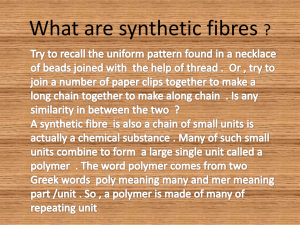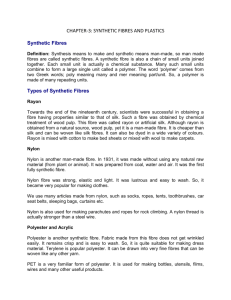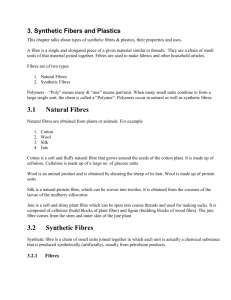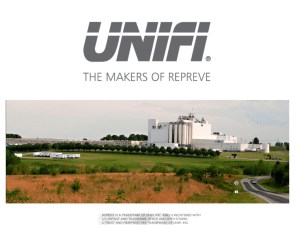Synthetic fibers and plastics
advertisement
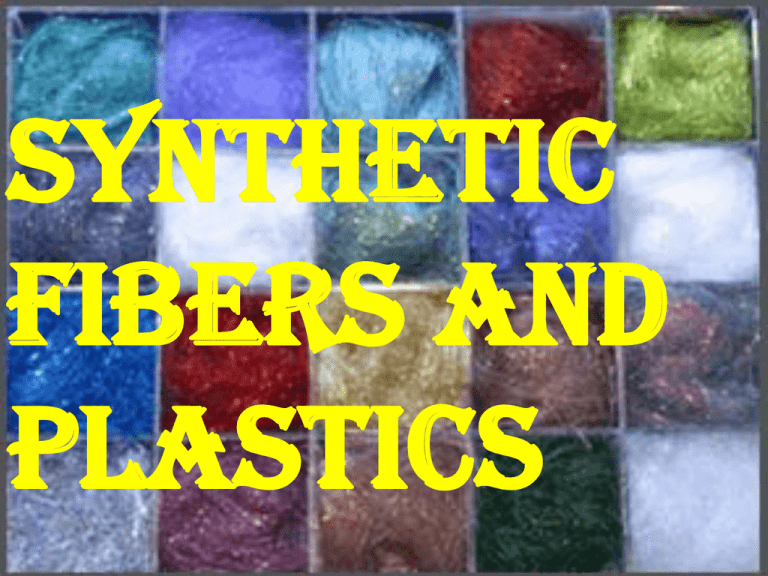
Synthetic fibers and plastics Index fibres • • • • Types of fibers Monomers and polymers Polymerization Polymers may be natural or synthetic Plastic products • Raw materials for synthetic Index Synthetic fibres • • • • • Rayon Nylon Polyester Acrylic Lycra or Spandex Plastics • Types of plastics • Plastics and there uses 1)Fibers Types of fibers Natural fibers Synthetic fibres Natural and synthetic Natural fibers come from natural sources like plants and animals. Synthetic fibres are man-made fibres. Synthetic fibres are made from different chemicals, hence each kind of synthetic fibres have their own properties. Synthetic fibres are more in length and are long lasting. The only limitation in synthetic fibres is that they are poor absorbents of moisture and they catch fire easily Monomers And Polymers Substances are made of units. A substance having a single unit structure forming its particles called a monomer. In certain substances thousands of units join together to form a large unit, called polymer (poly means many). Polymer is made of many repeating units. The process of joining together monomers to form a polymer is called polymerization. Polymerization (click on the box) Polymers may be natural……. Natural polymers: Natural fibers like cotton, wool and silk are polymers. Cotton is a polymer glucose. Wool and silk are the polymers of amino-acid (protein). Spider silk is one of the strongest natural polymers Or polymers can be synthetic Synthetic polymers: Synthetic polymers are made from chemical substances. They are plastic in nature . Nylon and polyster are synthetic fibres Example :next slide . Ethylene is a monomer obtained from petroleum. It’s chemical formula CH2. During polymerization many units of ethylene gets linked to form a chain as follows: CH2 CH2 CH2 CH2 CH2 This polymer is polyethylene, a kind of plastic- polythene Some polymers are made of two or more units. Example : nylon which is made of amine and adipi cacid. Like this: Plastic products Raw materials for synthetics Synthetic polymers : scientists evolved a mechanism to polymerize the monomers of certain substances like rubber, silicone and petroleum products such as ethane, propane, benzene, toluene, styrene, ester, and others. All these are raw materials for synthetic plastics Synthetic fibers In the east, including India, cotton, wool and silk and in the west it was leather, wool and fur which were the first materials to be used for clothings. Other natural fibres were also being used in different parts of the country depending upon their availability. It was towards the 1930s that synthetic fibre was developed. Most synthetic fibres are obtained from petroleum products, natural gas and coal by the process of polymerization. Rayon Rayon is prepared from cellulose. Though cellulose is a natural polymer it needs extensive chemical treatment to form rayon. Hence it is also considered as a semi-synthetic fibre. Advantage of rayon : it is cheaper to produce as compared to cotton itself since waste cotton and paper is used for making rayon. Secondly, rayon can be blended with other fibres like wool and silk. easily dyed and wooven into cloth good absorbent of sweat Properties of rayon lustrous in appearance drapes well Dress material because it is soft, silky and moisture absorbent Curtains because it drapes well Mixed with fibre glass for making helmets Reinforcing nylon tyres Uses of rayon Upholstery for luxury cars and officeand home furnishings Reinforcing nylon tyres Reinforcing nylon tyres Nylon Nylon was first developed by American scientist, Wallace H. Carothers for M/S Dupont de Nemours & Company of America in 1935. Chemically it is a ‘polyamide’, a polymer. It is the strongest synthetic plastic material which can be moulded to any shape. Nylon has many uses as fibre, as sheet and as moulded solids. People believe that nylon has been named since its products were simultaneously launched in New York (NY) and London (LON). toughest elastic material is lustrous and easy to wash can be made into palates or powdered high tensile strength Properties of nylon resists oil, grease, moths, fungus and other pests It can be moulded into fibres, bristles, sheets, rods, tubes and coatings slightly water absorbent, dries quickly Making sarees fishing nets and fishing lines Stretchable wears seatbelts upholstery Uses of nylon , tracksuits ropes raincoats. reel thread swimming wears thread, Polyester Alcohol and organic acid react together to make compounds called esters which are polymers. These are therefore called polyesters. If different alcohols and acids are used, different kinds of polyesters are made. Polyesters come under the brand names of ‘Terylene’, ‘Dacron’, ‘Terene’ and ‘Polyester’. Polyester is blended with cotton and wool in different ratios to obtain polycot or terrycot (polyester cotton) and polywool or terrywool (polyester wool) which is easily maintainable. Esters are compounds with fruity odour . resistant to pests and chemicals tough, light weight and elastic dries quickly Properties of polyester forms a permanent crease if heated and pressed easy to wash, does not shrink or stretch making magnetic audio and video cassattes and floppy disks. mixed with fibre glass for moulding it into helmets, protective sheets and hulls in boats Uses of polyester highly suitable for shirting, suiting, sarees and draperies Acrylic Acrylic fibre is commonly known by different trade names such as ‘Acrilan’, Orlon’, ‘Creslan’, and ‘Zefran’. It is a synthetic wool-like fibre with crimps Resistant to moths Can be dyed in different colors Soft with crimps resembling wool Properties of acrylic Also available in sheets Is durable light and washable Strong and stain resistant Acrylic knitting wool is good for baby wears because they are soft, warm and washable. A transparent type of acrylic is used to cover automobile lights, lenses surgical tools etc Uses of acrylic Used for making artificial fur, blankets, carpets etc. Lycra or Spandex a fibre with great elasticity stretches to 600 times with the ability to return to its original shape intact. It is greatly used by stage performers who require cloths with snug fitting. It is greatly used in swimming suits, t-shirts and universal size caps in combination with cotton. Plastics There is a great variety of plastics made from different chemicals. Property and uses of each kind of plastic depend upon the material being used for its synthesis (polymerization) Types of plastics Thermosets thermoplastics Thermoset plastics Thermoset plastics are hard and rigid. Example is Bakelite and melamine. Thermoset can be moulded to set it in any shape but it cannot be remoulded. It is dark in color, hard and resistant to heat and electricity. It is being widely used for the handle of kettles and pans. Earlier black telephone sets, electric switches, electric lamp holders, pins and plugs were made from thermoset plastic. It is also being used as a part of fibre glass sheet in the making of helmets. Melamine is a kind of Thermoset plastics used in good quality tableware. Melamine is also used as a coating on uniforms of firemen to make them fire resistant Examples of theroset plastics Thermoset handles A firemans uniform is coated with thermoset plastic to made it fire resistant Melamine wares An electric pin (black) Thermoplastics Thermoplastics are soft and flexib;e through they are not elastic like rubber and steel springs. They melt on warming and regain their shape on cooling. Thermoplastics can be drawn into fine fibers, moulded to any desired shape or stretched or spread as sheets. Some of the better known thermoplastics are nylon (polyamide), polyesters, polyethylene, polyvinyl chloride (PVC), acrylic, polyurethane, polypropylene (PP), poly-tetra-fluoroethylene (PTEE) etc Thermoplastics examples Plastic table and chairs Plastic food containers Plastic toys Plastic spoons and forks Plastic cups Plastic daily use items
